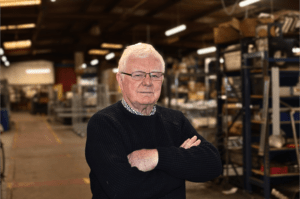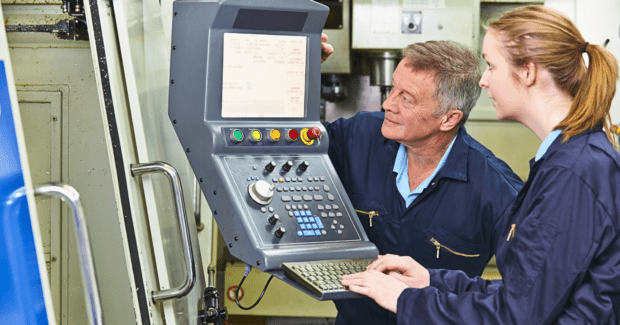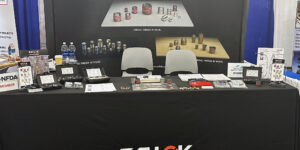Inspire and Attract Diverse Groups to Address Workforce Shortages
There are many initiatives and programs in operation when it comes to solving the manufacturing workforce shortage, which is at a critical point. By 2030, 4 million manufacturing jobs will likely be needed, and 2.1 million jobs are expected to…
Posted: February 20, 2024
There are many initiatives and programs in operation when it comes to solving the manufacturing workforce shortage, which is at a critical point. By 2030, 4 million manufacturing jobs will likely be needed, and 2.1 million jobs are expected to be unfilled if stakeholders do not inspire more people to pursue modern manufacturing careers, according to the National Association of Manufacturers.
Solutions include the continued automation of manufacturing equipment and processes and Industry 4.0 solutions. There are also any number of scholarships and monetary and equipment awards from suppliers and associations to students and training programs to encourage the next generations to explore manufacturing career opportunities.
There are also an increasing number of apprenticeships available, as well as educational pathways focused on manufacturing certifications and more. And there are continued increases in initiatives that focus on attracting more women and diverse groups of people such as those with disabilities, youth offenders, adult ex-offenders and others. The message about the benefits of manufacturing careers is reaching an ever growing numbers of potential workers.
Below we learn about two efforts that are making a difference in addressing workforce shortages.
Breaking Workforce Barriers Through Strategic Partnership

Students hired by Yaskawa Motoman work onsite at their high school one shift per day, which is equivalent to one class period.
To address labor gaps, customer demands and ongoing disruption, companies are turning to highly effective out-of-the-box ideas to bolster their workforces. As a result, strategic training programs and partnerships are forming within communities to cultivate the specific workforce required. For Alex, Brody, Cai and Evan of Valley View High School in Germantown, Ohio, a recent partnership — known as the Collaborative Change Partnership — is making a world of difference.
Spearheaded by Springfield, Ohio’s The Abilities Connection (TAC) and facilitated by the Strategic Ohio Council for Higher Education (SOCHE) out of Beavercreek, Ohio, these students are part of the Bridging Abilities work program. Geared towards students with disabilities and other barriers that are seeking to hone employment skills without leaving the classroom, this education model provides training for students, while letting them earn a paycheck and preparing them for life beyond the classroom. Michael R. Baker, TAC’s Transition Coordinator, confirmed: “The main focus of Bridging Abilities is to knock down barriers, and one of the best ways to do that is through employment.”
Passionate about helping people and local manufacturers succeed, the Ohio Manufacturing Extension Partnership (MEP), FastLane (Dayton, Ohio) was engaged in the partnership to help reach out to companies in the Greater Dayton Region that might be interested in participating in the program. Through this, Yaskawa America Inc. – Motoman Robotics Division (Yaskawa Motoman) was contacted.
“Being a part of the Collaborative Change Partnership seemed like a logical next step,” said Shannon Oyler, Yaskawa’s HR Generalist. “We’ve had good success with high school interns in the past, and this provided a way to broaden our workforce community while addressing the skills gap that is prevalent today.” Giving TAC, SOCHE and FastLane the green light to proceed, the students were vetted and hired, being matched specifically to the job Yaskawa Motoman had to offer.
Work Scope
Supervised by Valley View’s dedicated Intervention Specialist, Michele Hodson, the four students hired by Yaskawa Motoman work onsite at their high school one shift per day, which is equivalent to one class period. Currently, this time serves to assemble fuse holders. From screwdriving and snapping parts together, to placing informational stickers where needed, each student works independently to create an entire part before starting on the next. “It’s like putting together LEGO bricks,” Cai said. Once parts are assembled and complete, a quality check takes place by the Yaskawa receiving team, reassuring each part can be moved into usable stock. If an inspection reveals an anomaly, the part is flagged and feedback is given to the students via the Bridging Abilities leaders.
Partnership Benefits
“Hiring these students is a win-win,” said Mike Stava, Yaskawa’s senior director of operations. “Not only do bright, motivated high school students get the opportunity to work in manufacturing and gain real-world experience, but also, our organization can effectively increase our labor capacity by outsourcing the selected parts.” Long term, this model will help Yaskawa Motoman reduce overtime and provide a better work-life balance in the department that is normally responsible for producing the assemblies.
Started after the COVID-19 pandemic, this program is, “life impacting,” said Valley View High School Principal Patrick McKee. Hodson added: “This model provides broad opportunities the students are quite capable of doing, and it helps diversify their skills for a brighter future.” On the flip side, when the students were asked, “What is the best part about this job?” Brody said: “Trying something new.”
Along with the benefit of developing new skills, Baker from TAC confirms that the Bridging Abilities model provides positive outcomes in a variety of ways:
- Students – while fulfilling strategic Individualized Education Plan (IEP) goals, this program helps to personally empower students, and it provides a good transition between high school and employment opportunities after graduation.
- Teachers – this program is an encouragement to educators, and it helps them to see individual student strengths and skills in relation to work.
- Parents – this model boosts confidence and morale in relation to individual student skills and overall abilities, providing parents with a more positive outlook for their child’s future.
- Companies – while addressing the skills gap and diversifying the workforce, this program enables organizations to increase capacity to meet on-time delivery.
Future Outlook
Looking ahead, as the assembly of fuse holders progresses, Yaskawa hopes to add work opportunities for board assembly and interface assembly to the program, enabling more students to thrive. Moreover, it is the hope of all organizations involved with the Collaborative Change Partnership that more manufacturers will see the value in programs, like Bridging Abilities, and open their doors to more talented high school students in the near future.
Manufacturers Urged to Tap into Vital Skills of Retiring Workforce

Embrace the knowledge and skills of experienced team members before they retire in order to retain knowledge and experience within your shop.
Contributed by Metal Craft Industries Ltd.
As the sun sets on the careers of many skilled manufacturing professionals, Metal Craft Industries Ltd. (Wellingborough, Northamptonshire, UK), a leader in stainless steel fabrication of catering equipment, trolleys, sinks, and store equipment, is championing a call to action. The firm is urging manufacturers to harness the invaluable skills and experience of vital manufacturing workers who are on the verge of retirement before they exit the industry.
In a sector known for its intricacies and exacting standards, the expertise of veteran craftspeople is indispensable. As the manufacturing industry seeks to develop and inspire the next generation, there is a golden opportunity to tap into the knowledge that’s been honed over decades of service.
Reg Larkin, managing director and 33-year employee of Metal Craft Industries, underscored the importance of this initiative. “The UK has always been at the forefront of manufacturing excellence, and a substantial part of that legacy is owed to the countless professionals who have dedicated their lives to perfecting their craft,” Larkin said. “These skilled artisans possess an immeasurable wealth of knowledge that we simply cannot afford to lose. By engaging them in mentorship and training programs, we can ensure that their expertise is passed on to the next generation, securing the future of our industry.”
The focus on specialism, such as stainless steel fabrication of catering equipment, trolleys, sinks, and store equipment, presents a unique set of challenges and opportunities. It is in these niche sectors where specialized skills are vital, and the transfer of these skills should be prioritized.
At Metal Craft Industries, the emphasis on engaging retiring professionals has yielded positive results. The company’s commitment to this cause has not only benefited its own operations but also contributed to the wider manufacturing community. The firm’s structured mentorship programs have enabled them to retain and leverage the knowledge of industry experts, while simultaneously facilitating the development of the younger workforce.
“Our retiring professionals are not just leaving, they are transitioning into roles as trainers, passing on their skills to the next generation,” Larkin said. “This process of knowledge transfer ensures a smooth transition and enhances our productivity. The result is a win-win situation for both our experienced workers and the fresh talent.”
The manufacturing sector is at a crossroads, with opportunities for innovation and growth on the horizon. However, without a concerted effort to harness the knowledge and skills of retiring workers, it could find itself at a disadvantage. The call to action is clear: manufacturers should make the most of this golden opportunity to engage, train, and mentor retiring professionals to ensure the sector’s long-term sustainability.
Metal Craft Industries and other forward-thinking companies are ensuring that a new generation is ready to rise and shine. Together, they are fortifying the foundation of the manufacturing industry, securing its future for generations to come.













